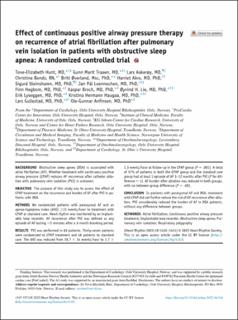| dc.contributor.author | Hunt, Tove Elizabeth Frances | |
| dc.contributor.author | Traaen, Gunn Marit | |
| dc.contributor.author | Aakerøy, Lars | |
| dc.contributor.author | Bendz, Christina | |
| dc.contributor.author | Øverland, Britt | |
| dc.contributor.author | Akre, Harriet | |
| dc.contributor.author | Steinshamn, Sigurd Loe | |
| dc.contributor.author | Loennechen, Jan Pål | |
| dc.contributor.author | Hegbom, Finn | |
| dc.contributor.author | Broch, Kaspar | |
| dc.contributor.author | Lie, Øyvind Haugen | |
| dc.contributor.author | Lyseggen, Erik | |
| dc.contributor.author | Haugaa, Kristina Ingrid Helena Hermann | |
| dc.contributor.author | Gullestad, Lars | |
| dc.contributor.author | Anfinsen, Ole-Gunnar | |
| dc.date.accessioned | 2023-01-30T12:35:13Z | |
| dc.date.available | 2023-01-30T12:35:13Z | |
| dc.date.created | 2022-10-24T12:48:49Z | |
| dc.date.issued | 2022 | |
| dc.identifier.citation | Heart Rhythm. 2022, 19 (9), 1433-1441. | en_US |
| dc.identifier.issn | 1547-5271 | |
| dc.identifier.uri | https://hdl.handle.net/11250/3047098 | |
| dc.description.abstract | Background
Obstructive sleep apnea (OSA) is associated with atrial fibrillation (AF). Whether treatment with continuous positive airway pressure (CPAP) reduces AF recurrence after catheter ablation with pulmonary vein isolation (PVI) is unknown.
Objective
The purpose of this study was to assess the effect of CPAP treatment on the recurrence and burden of AF after PVI in patients with OSA.
Methods
We randomized patients with paroxysmal AF and an apnea-hypopnea index (AHI) ≥15 events/hour to treatment with CPAP or standard care. Heart rhythm was monitored by an implantable loop recorder. AF recurrence after PVI was defined as any episode of AF lasting >2 minutes after a 3-month blanking period.
Results
PVI was performed in 83 patients. Thirty-seven patients were randomized to CPAP treatment and 46 patients to standard care. The AHI was reduced from 26.7 ± 14 events/hour to 1.7 ± 1.3 events/hour at follow-up in the CPAP group (P = .001). A total of 57% of patients in both the CPAP group and the standard care group had at least 1 episode of AF 3–12 months after PVI (P for difference = 1). AF burden after ablation was reduced in both groups, with no between-group difference (P = .69).
Conclusion
In patients with paroxysmal AF and OSA, treatment with CPAP did not further reduce the risk of AF recurrence after ablation. PVI considerably reduced the burden of AF in OSA patients, without any difference between groups. | en_US |
| dc.language.iso | eng | en_US |
| dc.publisher | Elsevier Inc. | en_US |
| dc.rights | Navngivelse 4.0 Internasjonal | * |
| dc.rights.uri | http://creativecommons.org/licenses/by/4.0/deed.no | * |
| dc.title | Effect of continuous positive airway pressure therapy on recurrence of atrial fibrillation after pulmonary vein isolation in patients with obstructive sleep apnea: A randomized controlled trial | en_US |
| dc.title.alternative | Effect of continuous positive airway pressure therapy on recurrence of atrial fibrillation after pulmonary vein isolation in patients with obstructive sleep apnea: A randomized controlled trial | en_US |
| dc.type | Peer reviewed | en_US |
| dc.type | Journal article | en_US |
| dc.description.version | publishedVersion | en_US |
| dc.source.pagenumber | 1433-1441 | en_US |
| dc.source.volume | 19 | en_US |
| dc.source.journal | Heart Rhythm | en_US |
| dc.source.issue | 9 | en_US |
| dc.identifier.doi | 10.1016/j.hrthm.2022.06.016 | |
| dc.identifier.cristin | 2064371 | |
| dc.relation.project | Norges forskningsråd: 309762 | en_US |
| cristin.ispublished | true | |
| cristin.fulltext | original | |
| cristin.qualitycode | 2 | |

